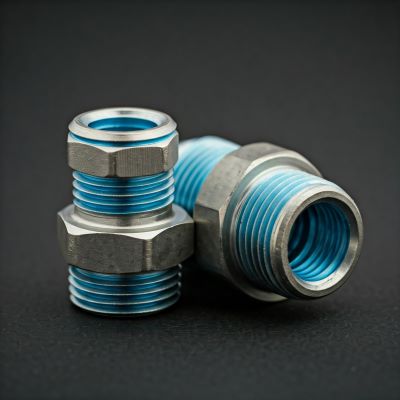When it comes to pipe threads, precision is key, and choosing the right type can make all the difference in ensuring a secure, leak-free connection. Among the many options, NPTF and NPT threads often come up as the top contenders. But what exactly differentiates them, and how do you know which one is best for your project?
Whether you’re working on plumbing, industrial systems, or manufacturing, understanding the subtle yet important differences between NPTF and NPT threads is crucial for achieving optimal performance and durability.
Let’s dive into these two thread types and help you make an informed decision for your next project.
Understanding the Basics of NPTF and NPT Threads
What Are NPTF Threads?
NPTF (National Pipe Taper Fuel) threads are a specialized type of tapered pipe thread designed for applications involving fuels, gases, and other fluids where the use of sealants like Teflon tape or pipe dope is undesirable or prohibited.
Why Thread Types Matter in Pipe Connections
The choice of thread type has a significant impact on the performance and reliability of pipe connections. Factors like leak resistance, pressure handling, and compatibility with different materials all depend on the specific thread design.
Key Differences Between NPTF and NPT Threads
Thread Design and Functionality Explained
➡️ NPT: Features a shallower taper and looser tolerances, requiring the use of sealants to prevent leaks.
➡️ NPTF: Has a steeper taper and tighter tolerances, allowing for a metal-to-metal seal without the need for sealants.
Sealability Comparison What Makes NPTF Unique?
➡️ NPT: Relies on sealants like Teflon tape or pipe dope to create a leak-proof seal.
➡️ NPTF: Designed to form a “dry seal” through close contact between the male and female threads.
Material Compatibility with NPT and NPTF Threads
➡️ NPT: Compatible with a wide range of materials, including metals, plastics, and some composites.
➡️ NPTF: Typically used with metals, as the dry seal relies on precise thread engagement.
Common Applications for NPTF and NPT Threads
Industrial Settings Where NPTF Excels
➡️ Fuel Systems: In automotive and aerospace applications, where fuel contamination is a concern.
➡️ Gas Lines: For natural gas, propane, and other gases where sealant residues can be hazardous.
➡️ High-Pressure Systems: Where the use of sealants may be impractical or unreliable.
Everyday Uses of NPT Threads in Plumbing
➡️ Domestic Plumbing: For connecting pipes, fittings, and fixtures.
➡️ Industrial Piping: In various industries for water, gas, and other fluids.
➡️ Automotive Applications: For fuel lines, oil lines, and other fluid systems.
Specialized Applications for Both Thread Types
Both NPT and NPTF threads find applications in:
➡️ Pneumatic Systems: For compressed air lines.
➡️ Hydraulic Systems: For high-pressure fluid transfer.
➡️ Machinery and Equipment: For connecting various components.
Factors to Consider When Choosing NPTF or NPT Threads
Pressure and Leakage Requirements
➡️ High-Pressure Applications: NPTF may be preferred for its superior sealing capabilities.
➡️ Low-Pressure Applications: NPT with appropriate sealants is generally sufficient.
Thread Strength and Durability
➡️ High-Vibration Environments: NPTF may offer better resistance to loosening due to its tighter seal.
➡️ General Use: NPT threads are typically strong and durable enough for most applications.
Cost Considerations for Each Thread Type
➡️ NPT: Generally more cost-effective due to the wider availability of fittings and the use of readily available sealants.
➡️ NPTF: May have higher costs due to the need for more precise manufacturing and potentially specialized fittings.
Tools and Techniques for Identifying Threads
Using Thread Gauges for Accurate Measurements
➡️ Thread Pitch Gauges: Determine how far apart the thread peaks are.
➡️ Thread Diameter Gauges: Determine the thread diameter.
Visual Differences Between NPTF and NPT
➡️ Taper Angle: NPTF generally has a steeper taper.
➡️ Thread Form: Minor variations in thread profile can be observed.
Tips for Avoiding Misidentification
➡️ Refer to Manufacturer Specifications: Always consult product documentation for accurate thread information.
➡️ Use Thread Gauges: For precise and reliable identification.
➡️ Seek Expert Advice: See a competent engineer or thread specialist if you’re not sure.
Installation Best Practices for NPTF and NPT Threads
Ensuring Proper Thread Engagement
➡️ Hand-Tighten First: Avoid cross-threading by carefully aligning the threads before tightening.
➡️ Use Appropriate Wrenches: Apply even pressure to prevent thread damage.
Sealant Options and Their Effectiveness
➡️ NPT: Use appropriate sealants like Teflon tape, pipe dope, or thread sealants.
➡️ NPTF: Avoid using sealants unless specifically recommended by the manufacturer.
Preventing Cross-Threading Issues
➡️ Align Threads Carefully: Ensure proper alignment before tightening.
➡️ Use Lubricants: Apply a small amount of lubricant to the male threads to facilitate smooth engagement.
Pros and Cons of NPTF and NPT Threads
Advantages of NPTF in High-Stakes Applications
➡️ Leak-Free Connections: Provides a reliable seal without the need for sealants.
➡️ Reduced Contamination Risk: Ideal for applications where fluid contamination is a concern.
➡️ Improved Durability: Can withstand higher pressures and vibrations.
Benefits of NPT for General Use
➡️ Versatility: Suitable for a wide range of materials and applications.
➡️ Cost-Effectiveness: Generally more affordable due to the use of readily available sealants.
➡️ Ease of Use: Simple to install and maintain.
Potential Limitations to Be Aware Of
➡️ NPTF: Limited material compatibility and may require specialized tools or techniques.
➡️ NPT: Requires careful application of sealants to ensure leak-free connections.
Final Thought
Choosing between NPTF and NPT threads requires careful consideration of the specific application requirements. By understanding the key differences, advantages, and limitations of each thread type, you can make an informed decision that ensures the reliability and safety of your piping systems.
If you are uncertain about the best thread type for your project, consult with a qualified engineer or thread specialist. They can provide expert guidance and help you make the most informed decision for your specific needs.
Post time: Jan-06-2025


